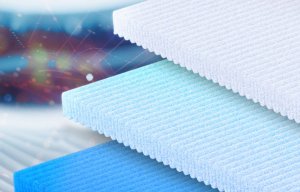
V/Smart nonwovens outperform PU foam
Opinion


The advanced position of the nonwovens industry in respect of many aspects of trade was apparent at INDEX 11, which took place from April 12-15th in Geneva, Switzerland. Needless to say, the show made new records in respect of both exhibitors and visitors. New classification for nonwovens? EDANA – the trade body primarily representing the European nonwovens industry – announced in Geneva that along with fellow trade organisations INDA, for North

27th April 2011
Adrian Wilson
|
Geneva

The advanced position of the nonwovens industry in respect of many aspects of trade was apparent at INDEX 11, which took place from April 12-15th in Geneva, Switzerland.
Needless to say, the show made new records in respect of both exhibitors and visitors.
EDANA – the trade body primarily representing the European nonwovens industry – announced in Geneva that along with fellow trade organisations INDA, for North America, and ANFA for Asia, there will now be a new initiative to have nonwovens defined entirely separately from textiles.
This is because nonwovens are currently classified under the Textiles and Textile Articles section of ISO 9093, for the purposes of international trade.
The three associations have described this definition as “grossly outdated, inadequate and inflexible”.
Consequently, fundamental changes under the Harmonised Commodity Description and Coding System (HS) are to be requested.
“In the last thirty years or so, nonwovens have seen tremendous growth in terms of volume of production and international trade, and considerable innovations in their three most important characteristics from the industrial viewpoint – their constituent materials and web forming and bonding methods,” explains EDANA general manager Pierre Wiertz. “The existing definition does not meet the current needs of either nonwoven producers or users, nor do the explanatory notes match the state of the art in nonwoven technologies.”
The modification that is to be requested calls for the creation of a chapter for nonwovens that is independent from textiles, paper or any other parent technology, and the implementation of new classification rules reflecting current technologies and products.
Submissions for the revision of HS will be jointly made by INDA, ANFA and EDANA to the World Customs Organisation through their respective national or regional authorities.
This is a very different approach from that being taken by other organisations representing Europe’s synthetic fibres and textiles industries, in requesting greater protection.
In his presentation at the Global Nonwovens Summit during the INDEX 11 event, Jacques Prigneaux, EDANA’s market analysis and economic affairs director, provided details of the very positive trade balance Europe’s nonwovens industry has – as compared to the general textiles sector.
“Without nonwovens in this equation, the decline of conventional textiles in Europe would be considerably worse,” he said.
Imports and exports of nonwovens also constitute only a small percentage of the nonwovens business in Europe. It’s an industry that is on the whole producing for its own use.
European nonwoven roll goods production was back on track in 2010. After a fall in 2009, European nonwoven roll goods output increased by almost 10% to 1.8 million tonnes and grew by 6.5% in terms of surface area.

I was also honoured to have been part of the judging panel for the INDEX 11 Innovation Awards, and the high standard of development work on all levels was apparent from the outset.
Among notable achievements, a favourite of mine was the Single Diaper Culling Technology which has been jointly developed by Italian disposables machinery manufacturer GDM and automation specialist Accusentry, headquartered in Georgia, USA.
This new system is capable of identifying and removing single disposable products which are damaged in any way, from fast-moving production lines.
It promises to be really revolutionary in eliminating waste – especially given the speeds of GDM’s own advanced disposable assembly machines which are now capable of producing well over 1,000 finished pieces a minute (depending on their assembly and end-use).
“The reduction in diaper waste of between 66 to 80% could lead to remarkable potential savings for hygienic disposable product manufacturers, with a significant environmental impact,” said EDANA’s Jean-Michel Ansbach, in presenting the Innovation Award for Machinery to the two companies.
![]()

Business intelligence for the fibre, textiles and apparel industries: technologies, innovations, markets, investments, trade policy, sourcing, strategy...
Find out more